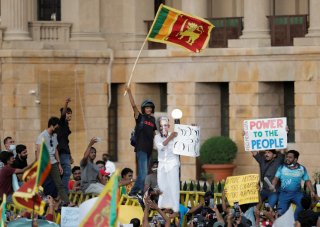Protesters Set Up Camps as Sri Lanka's Political Crisis Deepens
Sri Lanka’s economic crisis has steadily worsened since 2019, when Rajapaksa instituted major tax cuts that drained government coffers.
According to Al Jazeera, demonstrators in Colombo, Sri Lanka’s capital, have constructed a protest encampment outside the offices of President Gotabaya Rajapaksa in protest over Sri Lanka’s worsening political and economic crisis.
The protesters in the Galle Face Green—a stretch of waterfront in downtown Colombo and one of the wealthiest areas in Sri Lanka—initially established their encampment on Saturday and have reportedly vowed to remain in place until Rajapaksa resigns. The protesters have organized food and water deliveries, brought in portable toilets, and reportedly organized an impromptu concert on Thursday, with popular music alternating with chants urging “Gota,” an informal name for the president, to “go home.”
Sri Lanka’s economic crisis has steadily worsened since 2019, when Rajapaksa instituted major tax cuts that drained government coffers and impacted the government’s ability to maintain its budget and repay its international loans. The Rajapaksa government printed additional banknotes to address the shortfall, leading to hyperinflation and significantly devaluing the country’s currency, the Sri Lankan rupee. The economic crisis has also impacted the government’s ability to fund basic infrastructure, such as electricity and fuel. Power cuts and long lines for fuel and cooking gas have led to a growing protest movement against Rajapaksa, who initially responded by instituting emergency measures and a curfew, two developments that in turn led to more protests.
In an effort to lessen the effects of the crisis, Rajapaksa has since rescinded the emergency measures, fired the country’s finance minister, appointed a politically neutral economist to head the Sri Lankan central bank, and pursued emergency funding from the International Monetary Fund (IMF). However, these measures have failed to satisfy many of the protesters, who insist that Rajapaksa should step down as part of the government’s restructuring.
The protests are notable for their cross-sectarian nature, with participating members from all of Sri Lanka’s major ethnic and religious groups, including Sinhalese, Tamils, Buddhists, Muslims, and Christians.
Sri Lanka has historically been divided between the Sinhalese majority in the south and the Tamil minority in the north. After Sri Lanka’s independence in 1948, many Tamils favored an independent Tamil state, leading to a brutal twenty-six-year civil war between the Sri Lankan government and the “Liberation Tigers of Tamil Eelam,” better known in the West as the Tamil Tigers. The country has also experienced tensions between its Buddhist, Hindu, Muslim, and Christian populations.
As Sri Lanka’s defense minister, Rajapaksa played a key role in the defeat of the Tamil Tigers and the end of the civil war in 2009, which helped propel him to political stardom. He was elected president in 2019 after a campaign that his detractors argued had exploited ethnic and religious divisions to encourage voter turnout.
Trevor Filseth is a current and foreign affairs writer for the National Interest.
Image: Reuters

